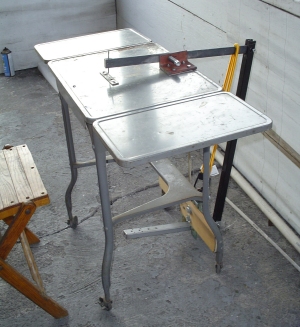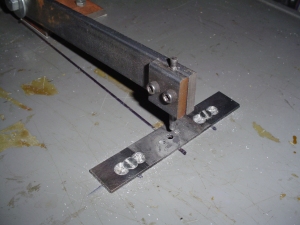 Click on the
image to see or download a higher resolution version.
Click on the
image to see or download a higher resolution version.These notes briefly outline how I constructed a traditional foot-operated, single-hole punch. There is a more complete description of my roll-punching experiences in the April 2008 issue of the COAA magazine The Carousel Organ in an article titled "Hand Punching My Own Rolls from Midiboek Templates." I will expand this page later.
I knew I had to meet about six critical requirements:
 Click on the
image to see or download a higher resolution version.
Click on the
image to see or download a higher resolution version.
This shows the overall configuration of my punch. Pressure on the foot treadle it transmitted to the punch rocker by a steel push-tube. Most of the return force is provided by the weight of the push-tube, but a loop of shock cord provides a bit more omph. I usually punch with the side extensions down, but use the extensions as a trimming and stapling table. The punch itself is made from oil-hardening drill rod. The die plate made from oil-hardening steel strip. I bought the heat-treatable steel from Enco (www.use-enco.com). All other metal came from scraps and a local home center.
The pivot-arm is made from a 19 inch piece of 3/16 by 1 inch hot-rolled steel bar. The pivot is located 11 1/2 inches from the rear end. The treadle is made from a 15 inch piece of 3/4 by 1 1/4 steel channel. The pivot is located 4 inches from the rear end.
 Click on the
image to see or download a higher resolution version.
Click on the
image to see or download a higher resolution version.
This shows the punch and die assembly. The punch is made from rod by lathe-turning a taper of about 3 degrees near both ends, making it reversible. Each die plate has a series of nine holes, allowing shifting between three positions as the holes dull. The attachment holes in the table surface are over sized. The punch is brought into the hole to set the plate's location, then the screws are tightened to lock it in place. Both parts were made from oil-tempering steel, heated until red hot, and dropped into waste motor oil.
I use free Midiboek software to print templates, and have produced my own rolls from my own MIDI arrangements. I use a dot-matrix printer, running MidiBoek under Windows '98, since Windows XP and Viata do not support banner printing. I print on traditional computer paper, then tape the joints with "scotch tape," trim the paper to 140 mm with a craft knife, and staple a second continuous strip of 140 mm paper behind the template. My punch easily handles two layers.
Right click on the image to download a higher resolution version.
These are scans of roll templates prepared with Midiboek for three different instruments, a standard “Raffin 20,” a “John Smith 20,” and a 15 note Kikkerland (Yunsheng) strip music box, along with the score for the same music. The bass notes are at the top, and the music has been transposed to fit the scale of each instrument.